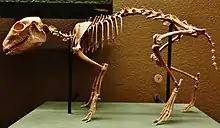Cainotherium
Cainotherium is an extinct genus of rabbit-sized prehistoric even-toed ungulates. These herbivores lived in Europe from the Eocene[2] until the early Miocene.[3] The skeletal anatomy of these hare-like animals suggest they, along with other members of Cainotheriidae, belong to the artiodactyl suborder Tylopoda, together with oreodonts and modern camelids. Species had cloven hooves, similar to those of bovids or deer, although the shape and length of the limbs suggests that the living animals moved by leaping, like a rabbit. The shape of the teeth also suggests a rabbit-like diet of nibbled vegetation, while the size of the auditory bulla and shape of the brain suggest that it would have had good senses of hearing and smell.[4][5]
_(1896)_(14775434603).jpg.webp)
Lithograph from 1896
| Cainotherium | |
|---|---|
 | |
| Restoration | |
| Scientific classification | |
| Kingdom: | Animalia |
| Phylum: | Chordata |
| Class: | Mammalia |
| Order: | Artiodactyla |
| Family: | †Cainotheriidae |
| Genus: | †Cainotherium Bravard, 1828 |
| Type species | |
| Microtherium renggeri[1] von Meyer 1837 | |
| Species | |
| |
| Synonyms | |
| |
References
- Lyell, Charles (1871). The student's elements of geology. p. 209.
- Prothero, Donald (2007). The Evolution of Artiodactyls. Baltimore, Maryland: The Johns Hopkins University Press. p. 69. ISBN 978-0-8018-8735-2.
- Prothero, Donald (2007). The Evolution of Artiodactyls. Baltimore, Maryland: The Johns Hopkins University Press. p. 71. ISBN 978-0-8018-8735-2.
- Savage, RJG; Long, MR (1986). Mammal Evolution: an illustrated guide. New York: Facts on File. p. 214. ISBN 0-8160-1194-X.
- Palmer, D., ed. (1999). The Marshall Illustrated Encyclopedia of Dinosaurs and Prehistoric Animals. London: Marshall Editions. p. 270. ISBN 1-84028-152-9.
This article is issued from Wikipedia. The text is licensed under Creative Commons - Attribution - Sharealike. Additional terms may apply for the media files.